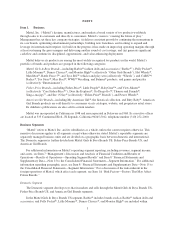Mattel 2010 Annual Report Download - page 21
Download and view the complete annual report
Please find page 21 of the 2010 Mattel annual report below. You can navigate through the pages in the report by either clicking on the pages listed below, or by using the keyword search tool below to find specific information within the annual report.preschoolers, girls’ toys, boys’ toys, youth electronics, digital media, hand-held and other games, puzzles,
educational toys, media-driven products, and fashion-related toys. Mattel competes domestically and
internationally with a wide range of large and small manufacturers, marketers and sellers of toys, video games,
consumer electronics and other play products, as well as retailers, which means that Mattel’s market position is
always at risk. Mattel’s ability to maintain its current product sales, and increase its product sales or establish
product sales with new, innovative toys, will depend on Mattel’s ability to satisfy play preferences, enhance
existing products, develop and introduce new products, and achieve market acceptance of these products.
Competition for access to entertainment properties could lessen Mattel’s ability to secure, maintain, and renew
popular licenses to entertainment products developed by other parties and licensed to Mattel or requires Mattel to
pay licensors higher royalties and higher minimum guaranteed payments in order to obtain or retain these
licenses. Competition is intensifying due to recent trends towards shorter life cycles for individual toy products,
the phenomenon of children outgrowing toys at younger ages, and an increasing use of more sophisticated
technology in toys. If Mattel does not successfully meet the challenges outlined above in a timely and cost-
effective manner, demand for its products could decrease, and Mattel’s revenues, profitability and results of
operations may be adversely affected.
Inaccurately anticipating changes and trends in popular culture, media and movies, fashion, or technology
can negatively affect Mattel’s sales.
Successful movies and characters in children’s literature affect play preferences, and many toys depend on
media-based intellectual property licenses. Media-based licenses can cause a line of toys to gain immediate
success among children, parents, or families. Trends in media, movies, and children’s characters change swiftly
and contribute to the transience and uncertainty of play preferences. In addition, certain developments in the
entertainment industry, including labor strikes, could cause delay or interruption in the release of new movies and
television programs and could adversely affect the sales of Mattel’s toys based on such movies and television
programs. Mattel responds to such trends and developments by modifying, refreshing, extending, and expanding
its product offerings on an annual basis. If Mattel does not accurately anticipate trends in popular culture,
movies, media, fashion, or technology, its products may not be accepted by children, parents, or families and
Mattel’s revenues, profitability, and results of operations may be adversely affected.
Mattel’s business is highly seasonal and its operating results depend, in large part, on sales during the
relatively brief traditional holiday season. Any events that disrupt Mattel’s business during its peak
demand times could significantly, adversely and disproportionately affect Mattel’s business.
Mattel’s business is subject to risks associated with the underproduction of popular toys and the
overproduction of toys that do not match consumer demand. Sales of toy products at retail are highly seasonal,
with a majority of retail sales occurring during the period from September through December. As a result,
Mattel’s operating results depend, in large part, on sales during the relatively brief traditional holiday season.
Retailers attempt to manage their inventories tightly, which requires Mattel to ship products closer to the time the
retailers expect to sell the products to consumers. This in turn results in shorter lead times for production.
Management believes that the increase in “last minute” shopping during the holiday season and the popularity of
gift cards (which often shift purchases to after the holiday season) may negatively impact customer re-orders
during the holiday season. These factors may decrease sales or increase the risks that Mattel may not be able to
meet demand for certain products at peak demand times or that Mattel’s own inventory levels may be adversely
impacted by the need to pre-build products before orders are placed.
In addition, as a result of the seasonal nature of Mattel’s business, Mattel may be significantly and adversely
affected, in a manner disproportionate to the impact on a company with sales spread more evenly throughout the
year, by unforeseen events, such as terrorist attacks, economic shocks, earthquakes or other catastrophic events,
that harm the retail environment or consumer buying patterns during its key selling season, or by events, such as
strikes, disruptions in transportation or port delays, that interfere with the manufacture or shipment of goods
during the critical months leading up to the holiday purchasing season.
13
























